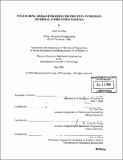Piston ring design for reduced friction in modern internal combustion engines
Author(s)
Smedley, Grant, 1978-
DownloadFull printable version (13.42Mb)
Other Contributors
Massachusetts Institute of Technology. Dept. of Mechanical Engineering.
Advisor
Tian Tian and Victor W. Wong.
Terms of use
Metadata
Show full item recordAbstract
Piston ring friction losses account for approximately 20% of the total mechanical losses in modern internal combustion engines. A reduction in piston ring friction would therefore result in higher efficiency, lower fuel consumption and reduced emissions. The goal of this study was to develop low-friction piston ring designs to improve engine efficiency, without adversely affecting oil consumption, blowby, wear, or cost. These are desirable objectives for today's engine manufacturers as they strive to improve engine performance while trying to meet increasingly stringent emissions regulations. Using an existing piston ring friction and lubrication model, the main contributors to friction in modern internal combustion engines were identified as the top ring around top dead center of the compression/expansion strokes and the oil control ring throughout the engine cycle. Model predictions indicated that the top ring friction could be reduced by implementing a skewed barrel profile design or an upward piston groove tilt design, and oil control ring friction could be reduced by decreasing ring tension. An increase in groove wear was predicted to occur with the upward piston groove tilt design, which could be eliminated by the introduction of a positive static twist on the top ring. An increase in oil consumption was predicted to occur with the low-tension oil control ring design, which could be mitigated either by the introduction of a negative static twist on the second ring, or by the implementation of the skewed barrel top ring design. Model predictions indicated that by combining the low-friction designs, a reduction in piston ring pack friction of 30-35% could be achieved, without an increase in blowby, wear, or oil consumption. (cont.) Experimental results conducted on a full-scale natural gas power generation engine supported the model predictions for the low-tension oil control ring design. The predicted reduction in piston ring friction would translate to a 0.5-1% increase in brake thermal efficiency, which would result in a significant improvement in fuel economy and a substantial reduction in emissions over the life of the engine.
Description
Thesis (S.M.)--Massachusetts Institute of Technology, Dept. of Mechanical Engineering, 2004. Includes bibliographical references (p. 113-115).
Date issued
2004Department
Massachusetts Institute of Technology. Department of Mechanical EngineeringPublisher
Massachusetts Institute of Technology
Keywords
Mechanical Engineering.